Illuminance and Starting Distance of the Far Field of LED-Array Luminaire Operated at Short Working Distance
Abstract
1. Introduction
2. Light Source and Luminare
3. Typical and Atypical Illumination Properties
4. Simplified Simulation of the Far Field
5. Conclusion
- The LED array forms unacceptable hotspots on the illumination plane when the observation distance is not sufficiently long.
- Hotspot removal depends on the factors including a larger divergent angle of the light source module, smaller light source array spacing, and longer observation distance.
- When the hotspot merges, central illuminance obeys the inverse-cosine law, with observation distance location being in the far-field region. A distance farther than the SDFF can be set as the working range.
- Under the small divergent angle of the light source and hollow array of the luminaire (i.e., serve conditions), SDFF is at most five times that of the luminaire dimension.
- The LCI distance is shorter than that of the SDFF in all cases. In other words, obtaining LCI in the far field region is difficult.
- For a specific real light source, simplified light sources such as a point source or a flat-extended source equipped with a corresponding cosine power factor of intensity can be used to determine the appropriate working range.
Author Contributions
Funding
Acknowledgments
Conflicts of Interest
References
- Cree: Continues to Push the Boundaries of LED Performance. Available online: https://www.cree.com/news-media/news/article/cree-first-to-break-300-lumens-per-watt-barrier (accessed on 28 April 2020).
- Sun, C.C.; Chang, Y.Y.; Yang, T.H.; Chung, T.Y.; Chen, C.C.; Lee, T.X.; Li, D.R.; Lu, C.Y.; Ting, Z.Y.; Glorieux, B.; et al. Packaging efficiency in phosphor-converted white LEDs and its impact to the limit of luminous efficacy. J. Solid State Light. 2014, 1, 19. [Google Scholar] [CrossRef]
- Narendran, N.; Maliyagoda, N.; Bierman, A.; Pysar, R.; Overington, M. Characterizing white LEDs for general illumination applications. Proc. SPIE 2000, 3938, 240–248. [Google Scholar] [CrossRef]
- Steigerwald, D.A.; Bhat, J.C.; Collins, D.; Fletcher, R.M.; Holcomb, M.O.; Ludowise, M.J.; Martin, P.S.; Rudaz, S.L. Illumination with solid state lighting technology. IEEE J. Sel. Top. Quantum Electron. 2002, 8, 310–320. [Google Scholar] [CrossRef]
- Zukauskas, A.; Shur, M.S.; Caska, R. Introduction to Solid-State Lighting; John Wiley & Sons: New York, NY, USA, 2002; ISBN 978-0-471-21574-5. [Google Scholar]
- Schubert, E.F.; Kim, J.K. Solid-state light sources getting smart. Science 2005, 308, 1274–1278. [Google Scholar] [CrossRef] [PubMed]
- Schubert, E.F. Light-Emitting Diods, 2nd ed.; Cambridge University Press: New York, NY, USA, 2006; ISBN 9780521865388. [Google Scholar]
- Krames, M.R.; Shchekin, O.B.; Mueller-Mach, R.; Mueller, G.O.; Zhou, L.; Harbers, G.; Craford, M.G. Status and future of high-power light-emitting diodes for solid-state lighting. J. Disp. Technol. 2007, 3, 160–175. [Google Scholar] [CrossRef]
- Pimputkar, S.; Speck, J.S.; DenBaars, S.P.; Nakamura, S. Prospects for LED lighting. Nat. Photon. 2009, 3, 180–182. [Google Scholar] [CrossRef]
- Karlicek, B.; Sun, C.C.; Zissis, G.; Ma, R. Handbook of Advanced Lighting Technology; Springer: Cham, Switzerland, 2017; ISBN 978-3-319-00175-3. [Google Scholar]
- Xie, R.J.; Hirosaki, N.; Kimura, N.; Sakuma, K.; Mitomo, M. 2-phosphor-converted white light-emitting diodes using oxynitride/nitride phosphors. Appl. Phys. Lett. 2007, 90, 191101. [Google Scholar] [CrossRef]
- Won, Y.H.; Jang, H.S.; Cho, K.W.; Song, Y.S.; Jeon, D.Y.; Kwon, H.K. Effect of phosphor geometry on the luminous efficiency of high-power white light-emitting diodes with excellent color rendering property. Opt. Lett. 2009, 34, 1–3. [Google Scholar] [CrossRef]
- Kuo, T.W.; Liu, W.R.; Chen, T.M. High color rendering white light-emitting-diode illuminator using the red-emitting Eu2+-activated CaZnOS phosphors excited by blue LED. Opt. Express 2010, 18, 8187–8192. [Google Scholar] [CrossRef]
- Wang, S.; Wang, K.; Chen, F.; Liu, S. Design of primary optics for LED chip array in road lighting application. Opt. Express 2011, 19, 716–724. [Google Scholar] [CrossRef]
- Lee, X.H.; Moreno, I.; Sun, C.C. High-performance LED street lighting using microlens arrays. Opt. Express 2013, 21, 10612–10621. [Google Scholar] [CrossRef] [PubMed]
- Lo, Y.C.; Cai, J.Y.; Tasi, M.S.; Tasi, Z.Y.; Sun, C.C. Side-illuminating LED luminaires with accurate projection in high uniformity and high optical utilization factor for large-area field illumination. Opt. Express 2014, 22, 365–375. [Google Scholar] [CrossRef] [PubMed]
- Kravchenko, S.V.; Byzov, E.V.; Moiseev, M.A.; Doskolovich, L.L. Development of multiple-surface optical elements for road lighting. Opt. Express 2017, 25, 23–35. [Google Scholar] [CrossRef]
- Martin, G.; Marty, C.; Bornoff, R.; Poppe, A.; Onushkin, G.; Marta, R.; Yu, J. Luminaire digital design flow with multi-domain digital twins of LEDs. Energies 2019, 12, 2389. [Google Scholar] [CrossRef]
- Moreno, I.; Avendaño-Alejo, M.; Tzonchev, R.I. Designing light-emitting diode arrays for uniform near-field irradiance. Appl. Opt. 2006, 45, 2265–2272. [Google Scholar] [CrossRef]
- Sun, C.C.; Lee, T.X.; Ma, S.H.; Lee, Y.L.; Huang, S.M. Precise optical modeling for LED lighting verified by cross correlation in the midfield region. Opt. Lett. 2006, 31, 2193–2195. [Google Scholar] [CrossRef]
- Chien, W.T.; Sun, C.C.; Moreno, I. Precise optical model of multi-chip white LEDs. Opt. Express 2007, 15, 7572–7577. [Google Scholar] [CrossRef]
- Sun, C.C.; Chien, W.T.; Moreno, I.; Hsieh, C.C.; Lo, Y.C. Analysis of the far-field region of LEDs. Opt. Express 2009, 17, 13918–13927. [Google Scholar] [CrossRef]
- Moreno, I.; Sun, C.C. LED array: Where does far-field begin? Proc. SPIE 2008, 7058. [Google Scholar] [CrossRef]
- Moreno, I.; Sun, C.C.; Rumen, I. Far-field condition for light-emitting diode arrays. Appl. Opt. 2009, 48, 1190–1197. [Google Scholar] [CrossRef]
- Goodman, J.W. Introduction to Fourier Optics; Roberts and Company Publishers: Greenwood Village, CO, USA, 2005. [Google Scholar]
- Moreno, I.; Sun, C.C. Modeling the radiation pattern of LEDs. Opt. Express 2008, 16, 1808–1819. [Google Scholar] [CrossRef] [PubMed]
- Cree Inc. Available online: https://www.cree.com/led-components/products/xlamp-leds-discrete/xlamp-xp-e (accessed on 28 April 2020).
- Chang, M.B. Total internal reflection lens. Appl. Opt. 1985, 24, 1256–1259. [Google Scholar] [CrossRef] [PubMed]
- Breault Research Organization: Advanced Systems Analysis Program. Available online: http://www.breault.com/ (accessed on 28 April 2020).
- Lewis, J.P. Vision Interface 95; Canadian Image Processing and Pattern Recognition Society: Quebec, QC, Canada, 1995; p. 120. [Google Scholar]
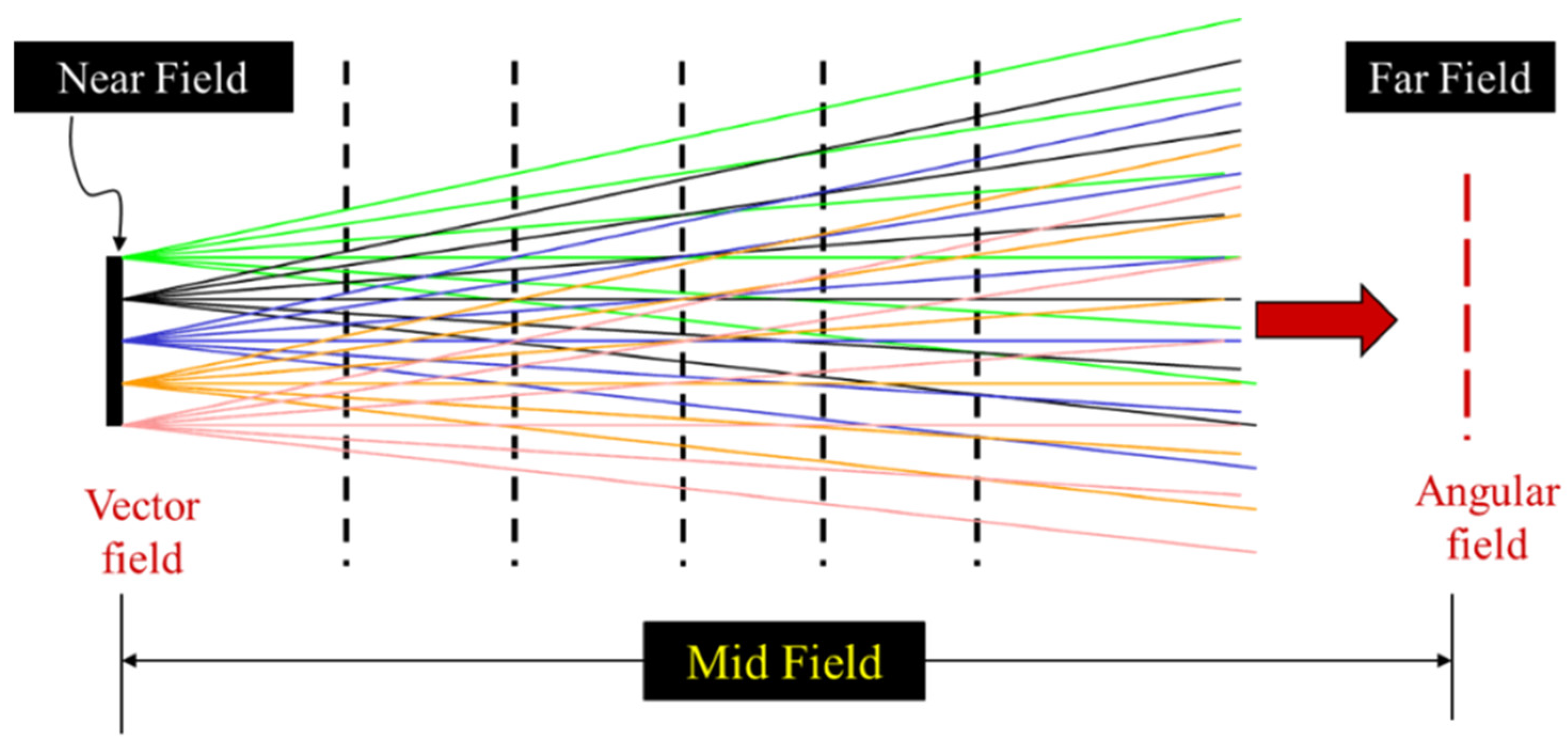
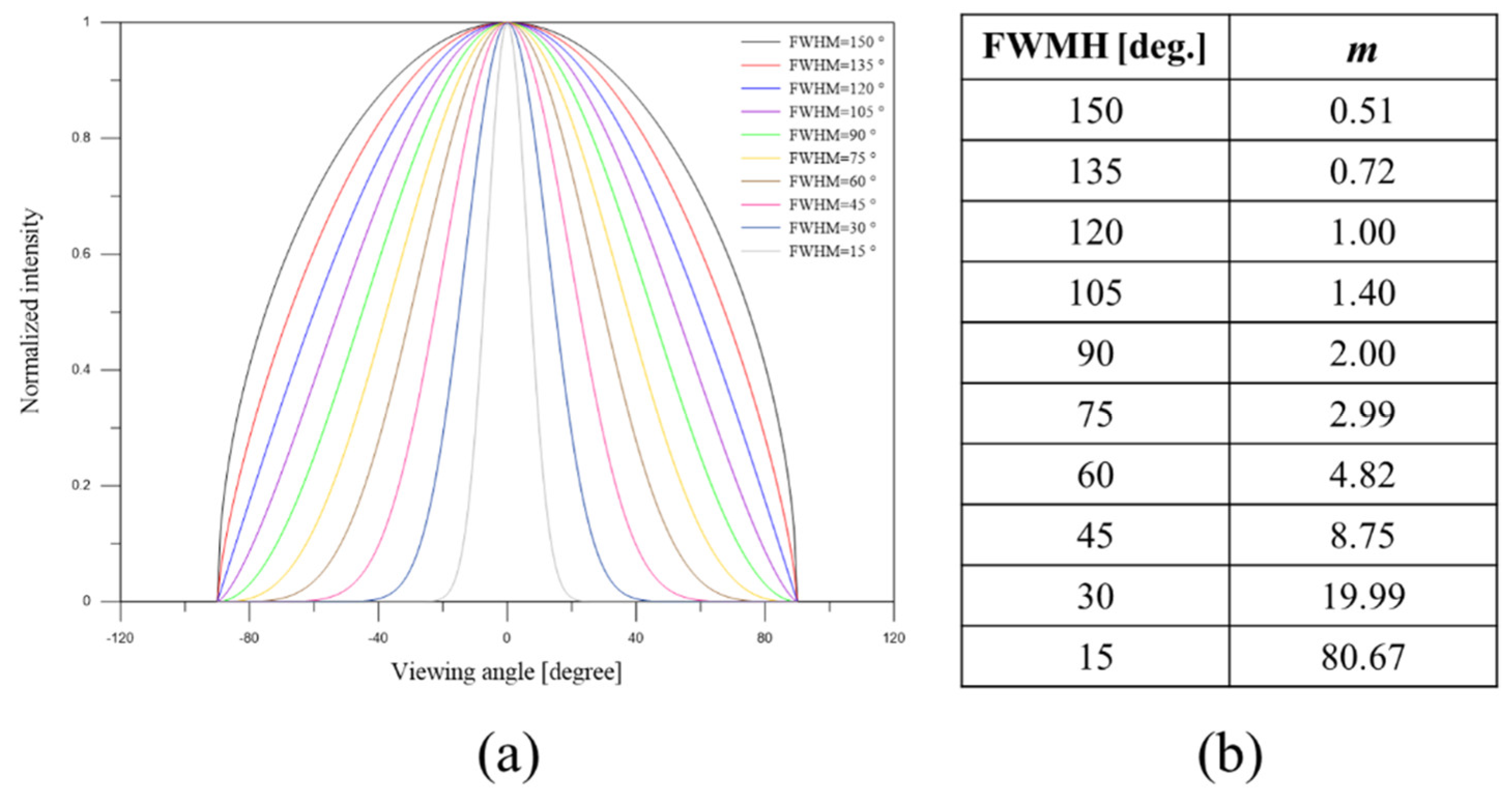

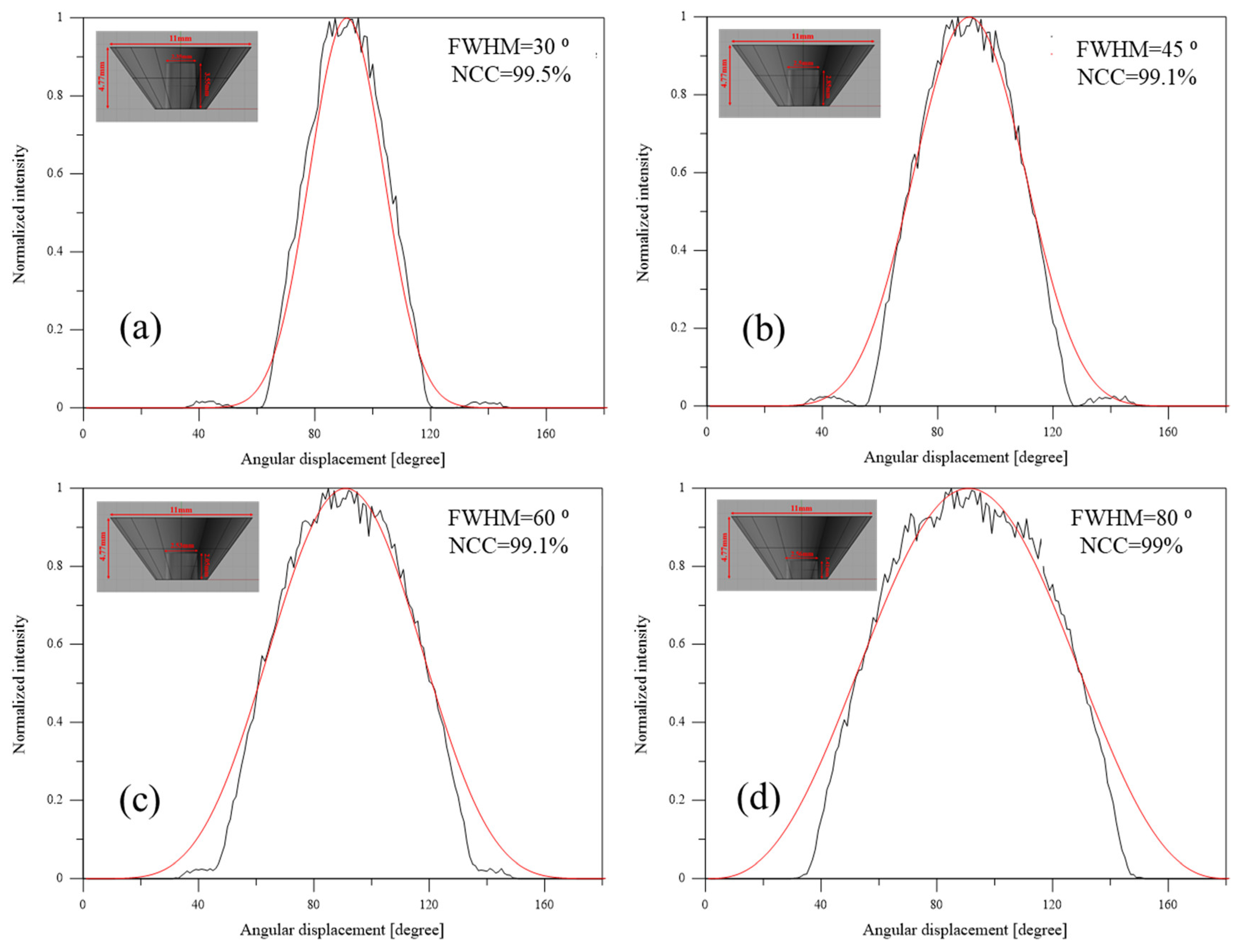
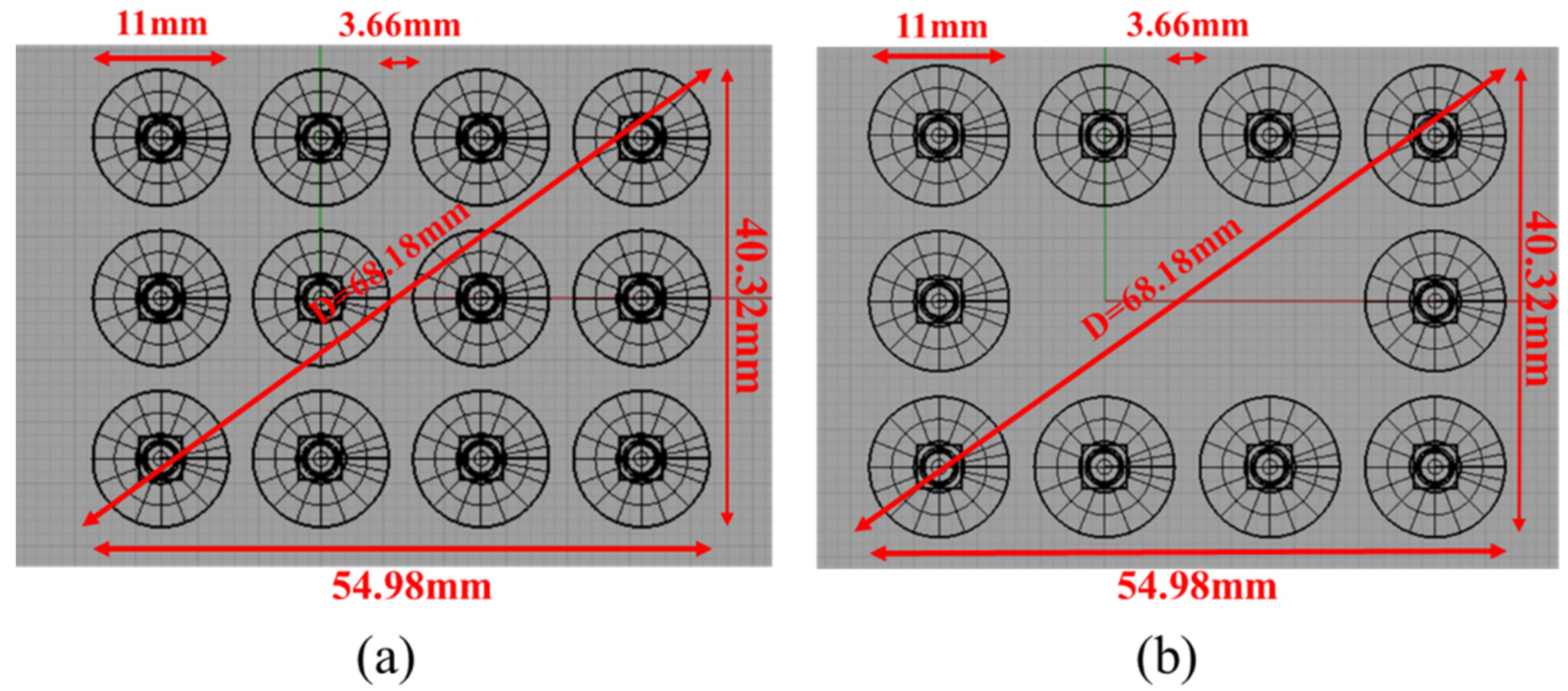
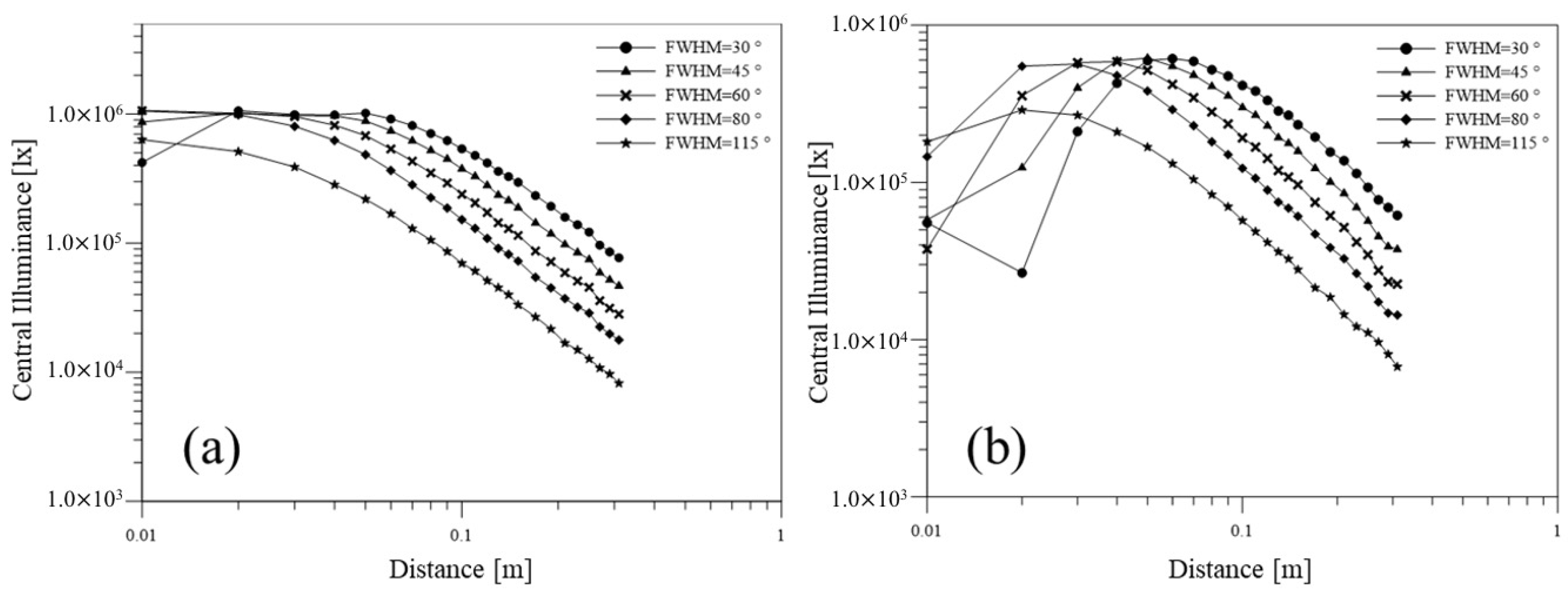
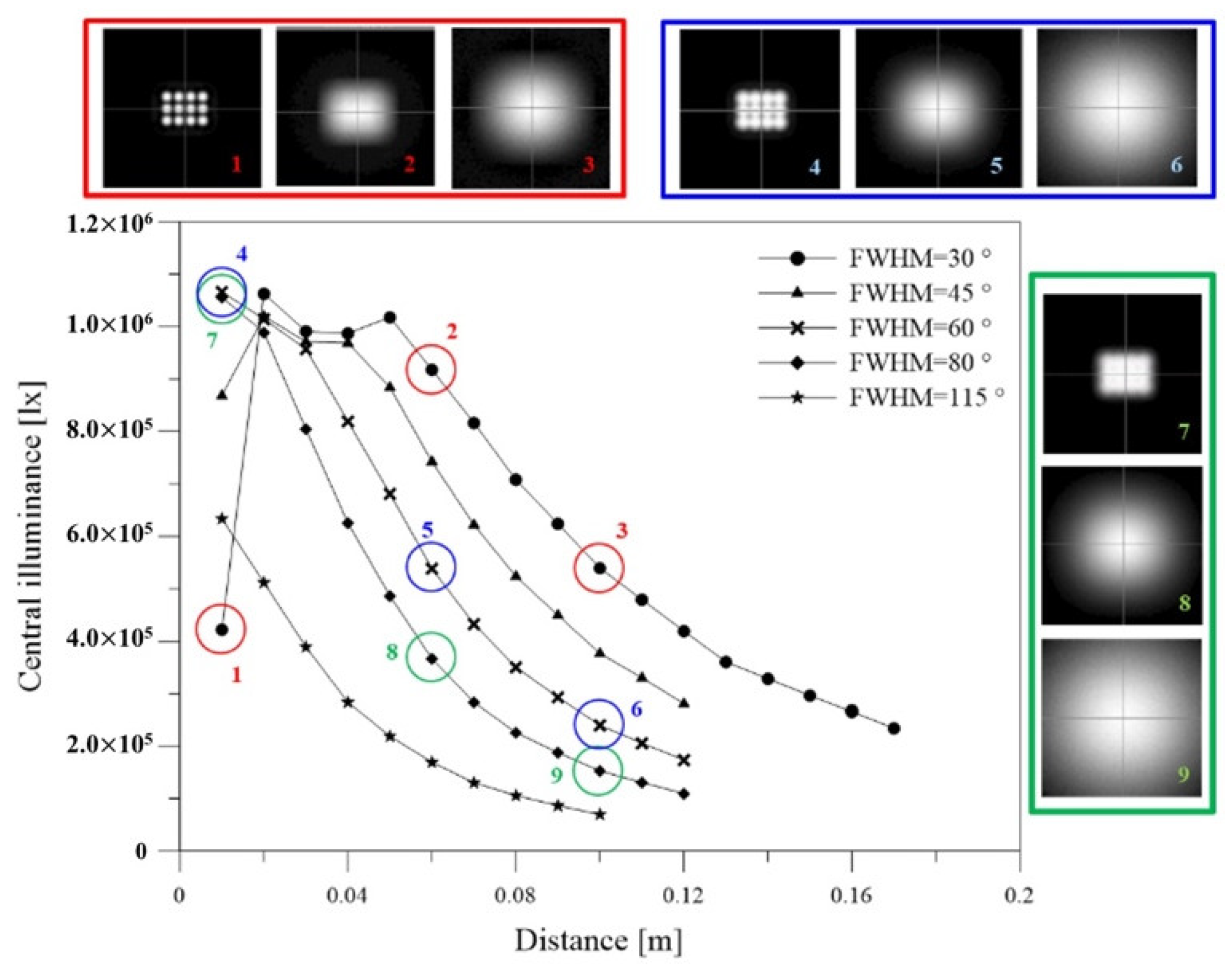
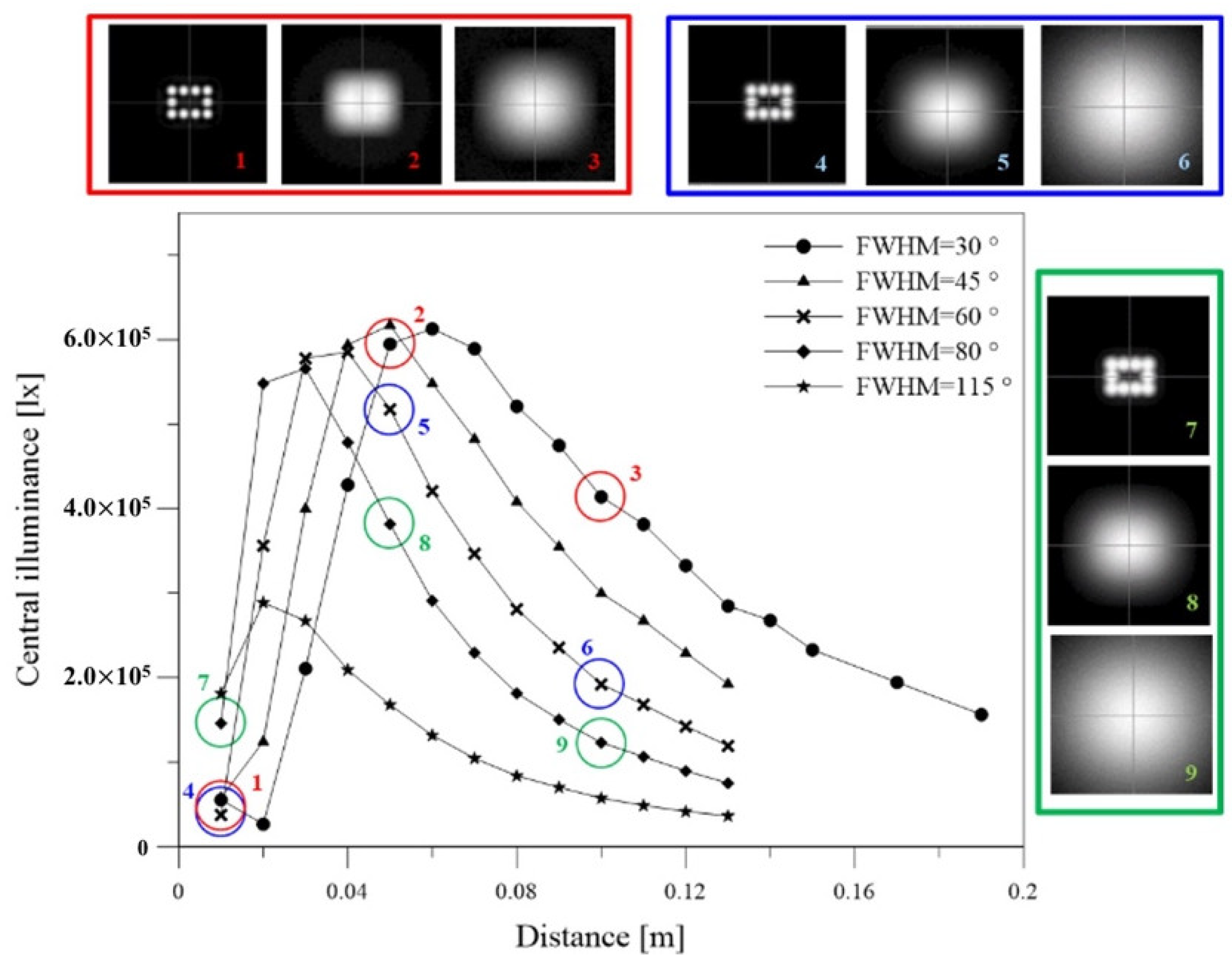

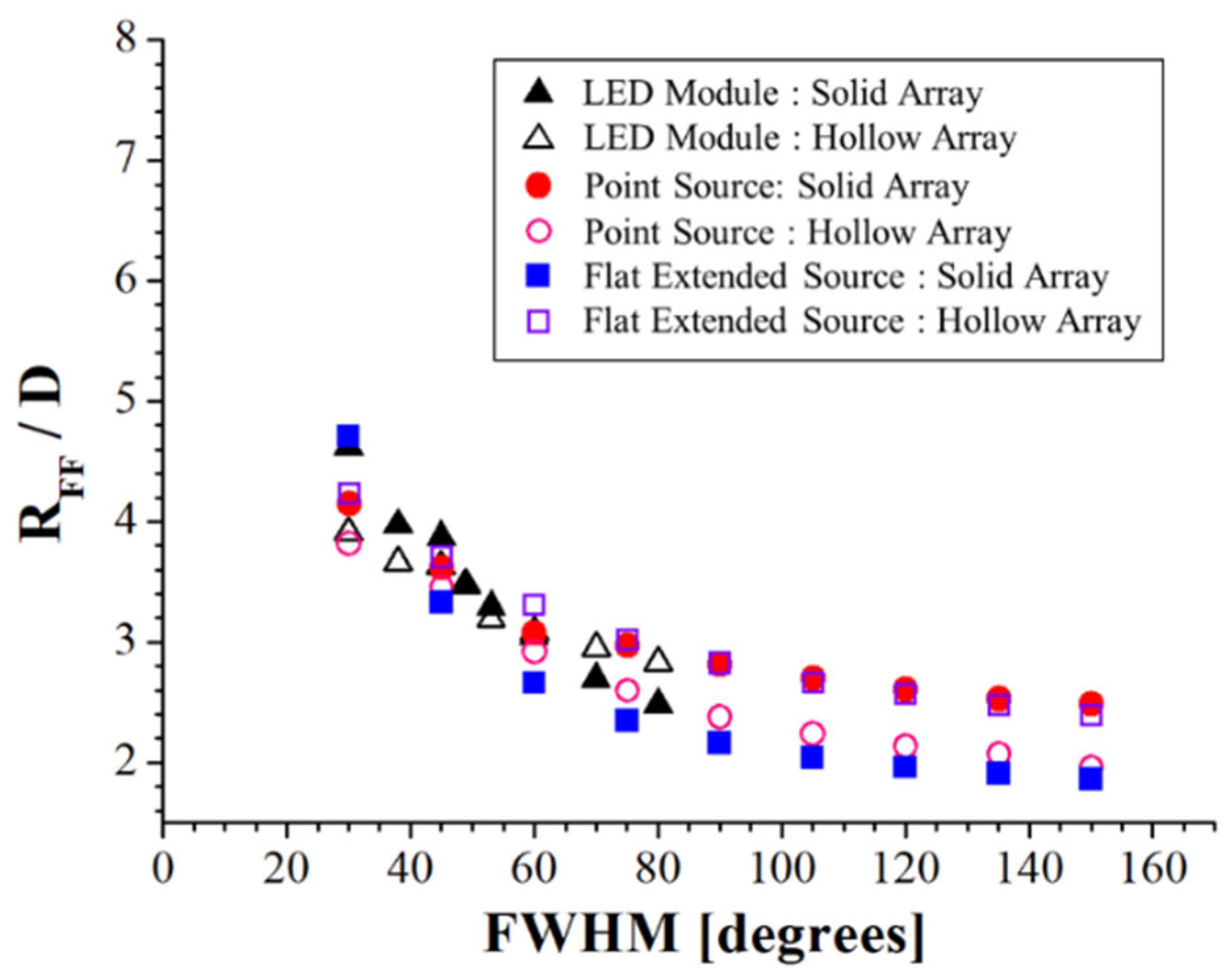
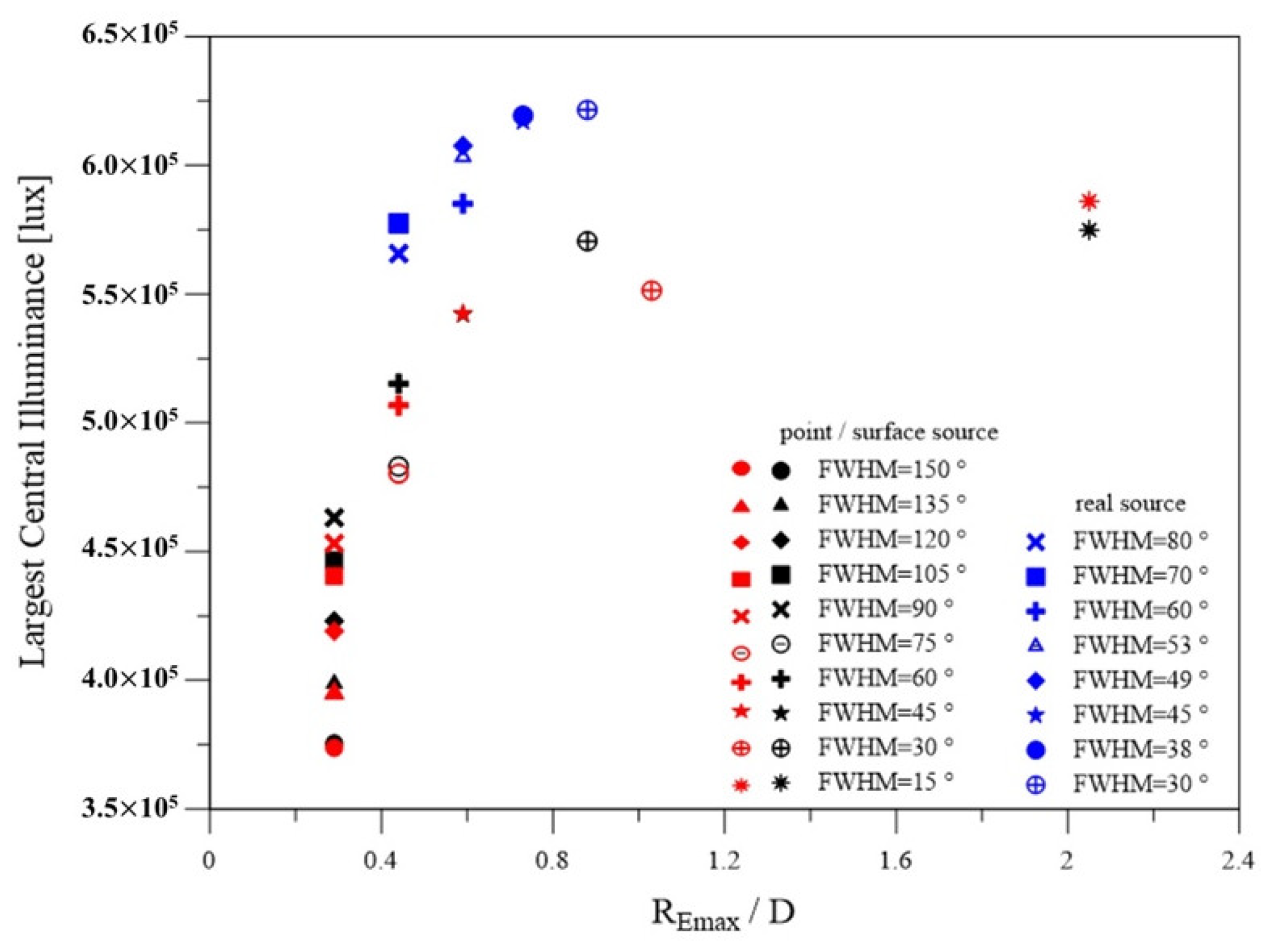
© 2020 by the authors. Licensee MDPI, Basel, Switzerland. This article is an open access article distributed under the terms and conditions of the Creative Commons Attribution (CC BY) license (http://creativecommons.org/licenses/by/4.0/).
Share and Cite
Sun, C.-C.; Lin, Y.-S.; Yang, T.-H.; Lin, S.-K.; Lee, X.-H.; Wu, C.-S.; Yu, Y.-W. Illuminance and Starting Distance of the Far Field of LED-Array Luminaire Operated at Short Working Distance. Crystals 2020, 10, 360. https://doi.org/10.3390/cryst10050360
Sun C-C, Lin Y-S, Yang T-H, Lin S-K, Lee X-H, Wu C-S, Yu Y-W. Illuminance and Starting Distance of the Far Field of LED-Array Luminaire Operated at Short Working Distance. Crystals. 2020; 10(5):360. https://doi.org/10.3390/cryst10050360
Chicago/Turabian StyleSun, Ching-Cherng, Yi-Syuan Lin, Tsung-Hsun Yang, Shih-Kang Lin, Xuan-Hao Lee, Chi-Shou Wu, and Yeh-Wei Yu. 2020. "Illuminance and Starting Distance of the Far Field of LED-Array Luminaire Operated at Short Working Distance" Crystals 10, no. 5: 360. https://doi.org/10.3390/cryst10050360
APA StyleSun, C.-C., Lin, Y.-S., Yang, T.-H., Lin, S.-K., Lee, X.-H., Wu, C.-S., & Yu, Y.-W. (2020). Illuminance and Starting Distance of the Far Field of LED-Array Luminaire Operated at Short Working Distance. Crystals, 10(5), 360. https://doi.org/10.3390/cryst10050360





